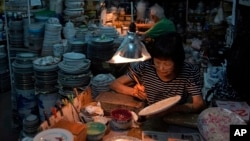Yuet Tung China Works is Hong Kong’s last remaining hand-painted porcelain factory. It is filled with dinnerware – plates, bowls, cups and more. They are all decorated by hand. The pieces have beautiful images of flowers, fruits and animals.
Joseph Tso is the third-generation owner of the factory. Tso and his small team are among the few people in Hong Kong who are experts at the traditional method of painting “guangcai,” or Canton porcelain.
It is a disappearing art in this modern city. Fewer young people are willing to put in the time and effort required to learn the art form or to work at the factory full-time.
Tso said, “The business environment in Hong Kong is not suitable for labor-intensive industries.” Labor-intensive industries require a large amount of work in relation to the amount of goods they produce.
Tso explained, “Hong Kong’s traditional handicraft industry is gradually declining. It will eventually disappear.”
Guangcai, which comes from the nearby Chinese city of Guangzhou, uses a special method known as an overglaze technique. The painter draws a design on white porcelain and then fills it in with color using thin brushes before heating the piece in a kiln.
Tso’s grandfather established the factory in Hong Kong’s Kowloon City in 1928. It became famous over the years for its craftmanship and specially-made dinnerware.
The factory is known for its Canton rose porcelain painted with a color called “xihong,” which means “Western red.” Its ingredients include lead oxide, quartz and gold dust.
“Hong Kong’s export sector was booming from the 1960s to the 1980s, and many well-known department stores came to buy products,” Tso said. “Foreign trade firms would bring us business from (American) department stores.”
The factory sometimes paints family crests - special pictures used to represent a family – on dinnerware for foreign buyers.
Chris Patten was the last British governor of Hong Kong before the city was returned to China in 1997. He visited Yuet Tung China Works to buy some porcelain before returning to Britain.
The factory is an important part of Hong Kong’s history, said Yim Wai-wai of The Hong Kong Ceramics Research Society.
“The porcelain factory breathed at the same pace as the development of Hong Kong,” said Yim. She added that if the factory stops its work, “it will be an immeasurable loss.”
I’m John Russell.
Katie Tam reported on this story for the Associated Press. John Russell adapted it for VOA Learning English.
_______________________________________________________________________
Words in This Story
porcelain – n. a hard, white substance that is very delicate and that is made by baking clay
decorated –adj. something made more appealing by placing a design on it
suitable –adj. having the right qualities for a particular use
handicraft – n. an activity that involves making something in a skillful way by using your hands: an object made by skillful use of your hands
kiln – n. an oven or furnace that is used for hardening, burning, or drying something (such as pottery)
ingredient – n. one of the things that are used to make a food, product, etc.
sector –n. an industry or area of an economy
pace – n. the speed at which something happens; the speed at which someone or something moves










